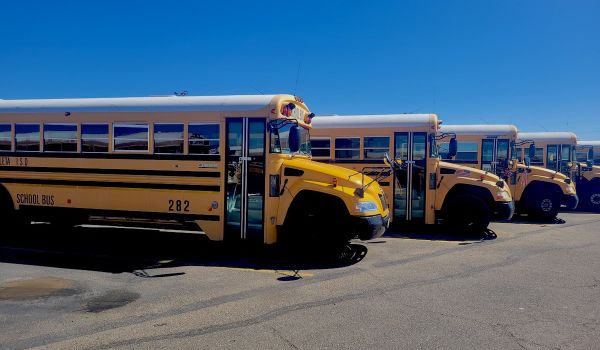This story was originally produced through the KUNC podcast The Colorado Dream’s six-part series, Housing Wanted.
The skies were blue and the mountain trails beckoned on a perfectly clear, warm summer day last June in Eagle, Colorado. Despite the beautiful day outside, Carrie Rogers was stuck indoors, packing her life into boxes and getting ready to move.
This was just the latest move in a long line of moves for Rogers, a tall, blond woman in her late 40s. Among all the odds and ends to box up, the contents of the junk drawer posed a particular conundrum.
“Do people pack up their junk drawers, or is it trash?” she sighed. “I mean, seriously…how many things of soy sauce does a person need?”
Roger’s disruptive chain of moves began with a big one about 10 years ago, when she left her native East Coast for the Colorado mountains and launched a brand new career in education.
“I had fallen in love with teaching,” she recalled.
But at the same time that Rogers was getting a foothold in the new career, she found herself on constantly shifting, unstable ground when it came to her housing situation.
That unstable housing situation has become a hallmark of life for Rogers and many other Eagle County School District employees. As the cost of housing rose sharply in recent years, teacher salaries did not keep up. The school district is now facing a severe staffing shortage due to the lack of affordable housing.
Over the years since Rogers arrived in Eagle County she has lived in a series of apartments that she found through word of mouth, often secured through informal agreements with the owner - that is, without a lease.
On her teacher’s salary, market-rate housing was never an option. Rogers has worked with a string of landlords who were willing to give her a break or agree to a barter situation, like dog sitting in exchange for a discount on rent.
“Any time I was able to find affordable rent, it was from people who really want teachers here. So they were making those sacrifices to not charge so much rent,” she said.
For a time, Rogers was willing to make sacrifices to break into her dream job while living in the dreamy Vail Valley. But now she’s grown exhausted and longs for the stability of owning her own home.
”It would be roots,” she said. “It would be security long term.”
But here’s the hard math she’s up against: First-year teachers in her school district start at around $50,000 a year. With 10 years and a master’s degree under her belt, Rogers earns about $65,000. Meanwhile, the median sale price for a home in Eagle County reached $1.3 million dollars in August 2023.
It finally dawned on Rogers that the numbers were never going to work in her favor.
“Why am I sacrificing this goal of being able to be a homeowner—and like, setting roots down and eventually being able to have a family—just so I can stay here and work my fingers to the bone to afford rent?” she wondered.
And Rogers is not the only teacher facing this difficult calculation.
A district-wide crisis calls for a district wide solution
Eagle County School District Superintendent Philip Qualman is unequivocal that the lack of affordable housing is causing a full-on staffing crisis in the local schools.
“We’ve lost some outstanding educators in my time in the district who could just no longer afford to be here,” Qualman said. “And every year we get people who accept positions, and then they end up declining after they look at the housing market and say, ‘I just can’t make it work.’”
According to Qualman, it’s a two-pronged problem. Experienced teachers leave when they grow into the phase of life when building equity becomes a priority, because it’s not realistic for them to buy a home in the area. At the same time, the scarcity of affordable rentals makes it hard to bring in new recruits.
“We are about to start our third year where we have about 10% of our positions vacant,” Qualman said of his district.
Eagle County isn’t an outlier when it comes to affordable housing, though. Across Colorado - particularly in the mountain resort communities and along the Front Range - the vast majority of teachers are not paid enough to buy a home in the district where they live and work.
Other mountain communities are also feeling the natural consequences of that stark reality. For instance, In a 2022 survey, nearly 42% of school district employees in Steamboat Springs said they would likely leave the area because of the a lack of affordable housing there.
By the time Qualman became superintendent in 2019, district officials were already strategizing how to tackle the staffing crisis by chipping away at the underlying housing crisis. In 2020, the district released a Housing Master Plan that set a new goal: to develop 120 new housing units for district staff by 2030. It called for a mix of affordable rentals and homeownership opportunities.
And that is how the Eagle County School District - an organization that, until recently, was solely focused on educating children - got into the business of affordable housing.
What sets Eagle County School District apart is that it is one of a handful of districts nationally that believe it is the responsibility of school districts to make sure staff can buy affordable homes where they work.
What the school district in Eagle County lacks in affordable housing development expertise, it makes up for in the most important affordable housing asset of all: land to build on. The district owns several parcels of land—large and small—throughout the Eagle River Valley.
Some of those district-owned parcels are already being developed.
The future of homeownership is savvy partnerships
Next to the football field at Eagle Valley Middle School, there’s a small hillside with patchy grass where the school district is now building one of its first affordable homeownership projects in partnership with Habitat for Humanity Vail Valley.
To pull it off, the school district donated the land to Habitat for Humanity for a development called the Third Street project. Twelve of the 16 homes that will eventually be on the site are reserved to be sold to school district employees.
Elyse Howard, development director with Habitat for Humanity Vail Valley, has been working on building affordable housing capacity in Eagle County for two decades. Over those years, she’s watched housing affordability slip away for many local workers.
“Most of our workforce doesn’t qualify to purchase a home on the open market,” Howard said.
Habitat for Humanity is known for making homeownership possible for low-income families. That’s the Habitat brand. In Eagle County, that usually means people who earn between 35% and 80% of the area median income, commonly called AMI. But homes in the Eagle River Valley have gotten so expensive that Habitat has had to expand how they define ‘low-income’ in order to work with the schools.
“We agreed that we would pilot, for Third Street, a higher AMI. We would go up to 100% AMI,” Howard said.
In Eagle County, 100% AMI is just over $118,000 for a family of four. According to the Eagle County School District, none of the district employees earn that much. The median district pay right now is just over $67,000 a year, which means that, barring a spouse with significant earnings, most teachers in the district could now qualify for a Habitat for Humanity home.
And on top of those changes, demand for Habitat homes has grown tremendously in recent years. Howard said they can’t keep up. When they started the Third Street project, applications went through a focused selection process. Habitat staff soon realized the demand for affordable housing was too great, however, and switched to a lottery system. In the end, 52 school employees applied for the 12 homes reserved for the district at the Third Street project, which means 40 educators who wanted to buy homes there were disappointed.
Rentals within reach
Last year, construction crews broke ground on a project aimed at tackling the other side of the school district’s housing problems: affordable rentals.
Miller Flats is the Eagle County School District’s first ground-up affordable apartment complex, just off of I-70 next to Battle Mountain High School in Edwards.
Construction crews here are building 37 apartment units - a mix of one-, two- and three-bedrooms - all for school staff. The district will rent them out at rates specifically designed to be affordable for employees.
Julian Millares has been watching the construction site with keen interest. Millares has years of experience as an educator in his home country of Colombia, but he just started his second year teaching second grade at Avon Elementary. He and his wife, Daniela Gonzalez, moved to the area on a J-1 visa so he could take the job.
Their housing story starts way back when they were still in Colombia. Millares had just accepted the job offer from Eagle Schools, and they were looking online for a place to live. It wasn’t going well, though.
“We didn’t find anything,” Millares said.
At the last minute, something did come through - a one bedroom apartment at a complex in Gypsum.
That apartment suited their needs, but they never had any options - never had an opportunity to choose where they wanted to live.
“This is … one of the only places that are affordable in the whole Eagle County,” Millares said.
And they don’t particularly enjoy living in Gypsum. On one hand, Millares has a long commute to the school where he teaches from their current apartment. Plus, compared to other parts of the valley, Gypsum lacks amenities and a convenient public transportation system, all of which has made it hard for Gonzalez, who works from home and doesn’t have her own car.
On top of that, the couple’s supposedly “affordable” apartment still costs $1,700 a month, which eats up a good chunk of their income. The couple started to question whether it was worth staying in the area.
Then Millares heard the district was building affordable staff housing in Edwards. The lower rent - one-bedroom apartments at Miller Flats go for $1,260 a month - would free up several hundred dollars each month. But best of all, the apartments would be just three miles from Millares’ school and located in a very walkable area.
“I immediately thought of my wife,” Millares said on hearing about the opportunity. “There’s a lot of things to do in Edwards.”
One hundred forty–four of his colleagues in the school district apparently thought similarly to Millares and Gonzalez. Applications for the 37 apartments poured in and the district held a lottery to distribute the units.
In the end, Millares and Gonzalez got lucky—their name came up high in the lottery results. They’ll get to move into a brand new one-bedroom apartment at Miller Flats next spring, which means Millares will be able to continue teaching Eagle County kids until his visa runs out in a few years.
A problem with no easy solution
Eagle County School District’s focus on affordable housing is helping to combat their staffing problems. When educators like Millares can afford to live where they work, they stay and contribute to the community.
The school district owns several more parcels of land where they’re planning to develop future affordable housing projects. One site in Minturn is big enough to fit 138 housing units. Officials recently submitted development plans for that project, and they hope to break ground on it sometime in 2025.
But there are still educators who aren’t being served, like Carrie Rogers, the special education teacher who was busy moving into a new apartment last June.
Rogers was among those dreaming of owning one of the staff Habitat for Humanity homes on Third Street, but ended up among the majority of applicants who were not chosen in the housing lottery.
Losing out on the Habitat for Humanity opportunity hit Rogers hard, and while she still managed to move into a great new apartment that she can afford, she’s grown weary of the perpetual, hopeless housing dance all-too-common in Colorado mountain towns. She’s determined that this will be her last apartment, and her last year, in Eagle. She plans to leave the area for good when the school year ends, taking her years of teaching experience with her.
This article is part of Backyard, a newsletter exploring scalable solutions to make housing fairer, more affordable and more environmentally sustainable. Subscribe to our weekly Backyard newsletter.
Rae Solomon is the Rural and Small Communities Reporter at KUNC.


















